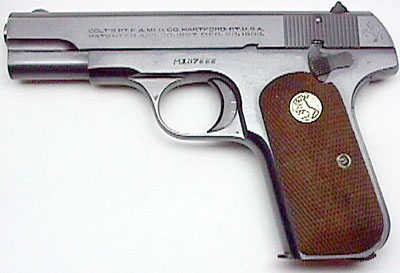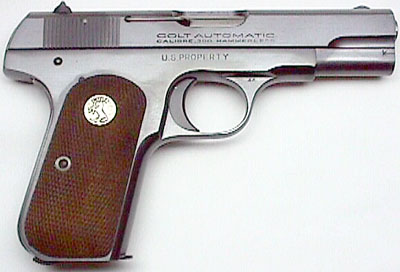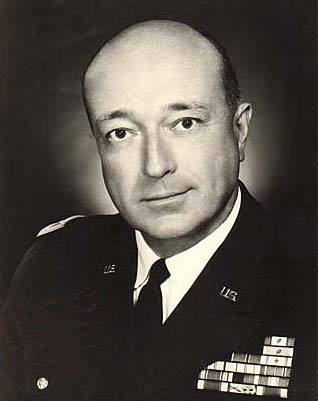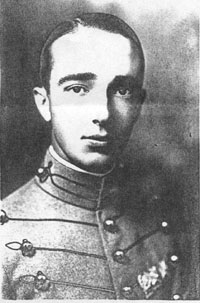| An exceptional Model M .380 pistol issued to Lt. General Marshall S. Carter - On
April 8, 1947, he was appointed to the rank of Brigadier General and was
presented his Colt 1908 .380 caliber sidearm, serial number 137666 on May
5, 1948. The Certificate of Ownership for this pistol was later presented
to Lieutenant General Carter on May 12, 1965, while stationed at Fort
McNair, Washington, D.C. 
This gun has the "M" stamp preceding the
serial number on the frame and on the toe of the magazine, which indicated
that it has been either issued from the factory with or sent back to the factory for modifications to the
ejector and magazine to correct a problem that caused a stovepipe
jam.


Lieutenant General Marshall
Sylvester Carter
(September 16, 1909 - February 18, 1993)
Marshall Sylvester Carter was born into a military family September 16,
1909 at Fortress Monroe, located in Elizabeth City County, Virginia, to
Brigadier General Clifton Carroll Carter
and Mai Coleman Carter.
At age 2, when his father was assigned in Hawaii, a Japanese nurse began
calling him "Pat," and he was known by that nickname for the
rest of his life.
General Carter attended West Point grammar school in West Point, New
York (1922), Cornwall on Hudson high school in Cornwall on Hudson, New
York (1926) and The Tome School, which was a preparatory school located in
Port Deposit, Maryland (1927).
 General Carter
was appointed to the United States Military Academy from the State of New
York by Senator Royal S. Copeland. He began his career at the Academy on
July 1, 1927. He graduated from there and received a Bachelor of Science
degree on June 11, 1931. Upon graduation from the Academy, he was awarded
the rank of 2nd Lieutenant. While at West Point, he played on the ice
hockey team, and the sport became one of the great loves of his life. He
later served as a director of the International Ice Hockey Federation and
on the U.S. Olympic Committee. In 1936, General Carter earned a Masters of
Science degree at the Massachusetts Institute of Technology. General Carter
was appointed to the United States Military Academy from the State of New
York by Senator Royal S. Copeland. He began his career at the Academy on
July 1, 1927. He graduated from there and received a Bachelor of Science
degree on June 11, 1931. Upon graduation from the Academy, he was awarded
the rank of 2nd Lieutenant. While at West Point, he played on the ice
hockey team, and the sport became one of the great loves of his life. He
later served as a director of the International Ice Hockey Federation and
on the U.S. Olympic Committee. In 1936, General Carter earned a Masters of
Science degree at the Massachusetts Institute of Technology.
In 1934 he married Préot Nichols,
his wife of 58 years. They had three children Josephine Stoney Carter (b.
August 1, 1938), Marshall Nichols Carter (b. April 23, 1940) and Mary
Coleman Carter (b. March 18, 1945).
Upon graduation from the USMA, General Carter was assigned Special
Liaison Duty as First Military Observer with the United States Naval
Academy on the U.S.S. Wyoming from June 22 to August 26, 1931. From
September 14, 1931 to April 11, 1932, he was a Battery Officer in the 12th
Coast Artillery at Fort Monroe, Virginia. From Virginia, General Carter
was next stationed as Battery Officer and Battalion Adj. for the 64th
Coast Artillery, (Anti‑Aircraft) at Fort Shafter, Honolulu, HI from
June 1, 1932 to March 23, 1935. While completing his Masters Degree at MIT
on June 9, 1936, General Carter worked as an instructor in the Department
of Natural & Experimental Philosophy at the USMA from April 21, 1935
to July 9, 1939.
He completed the Battery Officers Course at Fort Monroe, Virginia as a
student officer at the Coast Artillery School from September 8, 1939 to
February 1, 1940. Upon completion of this course, General Carter served as
an instructor there from February 1940 to August 1940. Additionally,
General Carter was a student instructor at the Stereoscopic Height Finders
School detail through May 1940. In June 1940, General Carter was in
Washington, D.C. attending the Student Naval Optical School.
In August 1940, he went to Quarry Heights in the Panama Canal Zone and
served as the Battery Officer for the 73rd Coast Artillery (Anti-Aircraft).
In July 1941, while stationed at the Panama Canal Zone, General Carter
became the Organizer and Director of the Enlisted Specialist School, a
position he held until December 1941. In December 1941, he became
Assistant ACofS, G-3 for the Panama Coast Artillery Command.
Shortly after Pearl Harbor and for the duration of World War 2, General
Carter was ordered back to Washington, D.C. where he was a Staff Officer
assigned to the Operations Division War Department General Staff, (OPDWDGS),
through June 1945.
In the Spring of 1945, General Carter was in Paris, France for the
celebration of V‑E Day. For a year and a half, from July 1945
through January 1946, he was posted in Chungking and Shanghai, where he
was Deputy and Assistant Chief of Staff (G-5) at China Theater
headquarters.
From January 1946 through March 1946, General Carter was stationed in
Washington, D.C. as the Executive Assistant to the Assistant Secretary of
War. Upon completion of this duty, he was appointed Special Representative
for General George C. Marshall to "hold General Marshall's horse for
the year he was in China",
while General Marshall served as a Presidential Messenger to China from
March 1946 through January 1947.
In the course of his military career, General Carter was a key
staff assistant to General George C. Marshall, the Army chief of staff.
He attended six major international conferences and accompanied
Marshall to five of the six: the World War II Allied summit in Cairo,
Egypt in 1943; the Council of Foreign Ministers in Moscow in 1947; the
Inter-American Conference for Maintenance of Peace and Security in Rio de
Janeiro, Brazil in 1947; the Second Session of General Assembly of the
United Nations, New York, NY in 1947(without Marshall); the Ninth
International Conference of American States in Bogotá, Colombia, in 1948;
and the Third Session of the United Nations General Assembly in Paris in
1948. He served as Marshall's special representative in Washington
while Marshall was serving as special envoy in China.
This position he held until named Special Assistant to the Secretary of
State in January 1947 when General Marshall became Secretary of State
after the war. Two years later, in March 1949, General Carter became
Deputy to the Ambassador for Military Assistance Programs for Europe with
station at the American Embassy in London. Concurrently, he served as
Deputy Chairman, European Correlations Committee. In these capacities,
General Carter held the personal rank of Minister.
In March 1949, he went to London, England as Minister of the American
Embassy, Deputy Chairman of the European Correlation Committee for
Military Assistance to work on military assistance programs for Europe. He
returned from Europe and became a Department of State student at the
National War College from August 1949 to June 1950.
Following a short tour as Commander of the 138th Anti-Aircraft Group in
Japan, in 1950 General Carter was recalled to Washington by General
Marshall, to become Director of the Executive Office of the Secretary of
Defense. General Carter served in this capacity during the Korean War
under General Marshall and his successor, Mr. Lovett until November 1952.
From 1952 to 1955, General Carter was at Fort Richardson, Alaska as
Deputy Commanding General of the 71st Infantry Division. His next post was
Fort Sheridan, Illinois, where from June 1955 until June 1956, he was
Commanding General of the Fifth Region, Army Anti-Aircraft Command.
For the next five months, he served as Deputy Commanding General of the
Army Anti-Aircraft Command in Colorado Springs, Colorado, leaving this
assignment to become Chief of Staff of the newly formed Continental Air
Defense Command at Ent Air Force Base from October 1956 until September
1957. When this command was expanded into the North American Air Defense
Command in September 1957, General Carter also became Chief of Staff of
this two-nation unified command, the first command of this type in the
United Stated. While serving there, he was a prominent member of an
informal group called the Range Riders, whose members regularly rode
horseback around Pike's Peak. He also enjoyed hunting, fishing, camping,
ice skating and skiing.
General Carter's final two assignments before his appointment as deputy
director of the CIA in April 1962 were as Chief of Staff of the 8th Army
in Korea from December 1959 to January 1961 and commander of the Army Air
Defense Center and Air Defense School at Fort Bliss, Texas from March 1961
to March 1962.
The White House announced on March 9, 1962, that President John F.
Kennedy had selected Major General Carter to be Deputy Director of the
Central Intelligence Agency from 1962 to 1965. He was nominated by
President Kennedy on March 12, 1962 and confirmed by the Senate on April
2, 1962, with the rank of Lieutenant General. President Lyndon B.
Johnson nominated General Carter to be Director of the National Security
Agency, a position which he held from 1965 to 1969. General Carter was
known in the military and intelligence communities as an efficient but
relaxed and informal "feet-on-the-desk" type of officer with a
vast and detailed knowledge of world figures and events.
In 1969, after four years of service as director of the National
Security Agency, General Carter retired from the Army. He had lived since
then in Colorado Springs. From 1969 until 1985, he was president of the
George C. Marshall Foundation in Lexington, Virginia.
At the age of 83, Marshall Sylvester Carter, died of liver cancer
February 18, 1993 at his home in Colorado Springs. His survivors include
his wife, Préot Nichols Carter, whom he married in 1934, of Colorado
Springs; three children, Stoney Carter of Colorado Springs, Mary Carter
Nickerson of Denver and Marshall N. Carter of Boston; eight grandchildren;
and a great-grandchild.
PROMOTIONS
General Carter received the following promotions throughout his
military career:
|
Promotions
|
Temporary (AUS)
|
Permanent (RA)
|
|
2nd
Lt
|
|
11 June 1931
|
|
1st
Lt
|
|
1 August 1935
|
|
Captain
|
9 September 1940
|
11 June 1941
|
|
Major
|
1 February 1942
|
|
|
Lt.
Colonel
|
14 October 1942
|
1 July 1948
|
|
Colonel
|
24 July 1944
|
|
|
Brig.
General
|
8 April 1947
|
|
|
Colonel
|
3 August 1949
|
3 August 1953
|
|
Brig.
General
|
27 July 1951
|
15 March 1959
|
|
Major
General
|
21 December 1955
(w/DOR I July 1951)
|
|
|
Lieut.
General
|
1 April 1962
|
|
On April 8, 1947, he was appointed to the rank of Brigadier General.
He was presented his Colt 1908 .380 caliber sidearm, serial number 137666
on May 5, 1948. The Certificate of Ownership for this pistol was later
presented to Lieutenant General Carter on May 12, 1965, while stationed at
Fort McNair, Washington, D.C.
DECORATIONS
Lieutenant General Carter's citations and decorations included a
Distinguished Service Medal with two oak leaf clusters, a Legion of Merit
with one oak leaf cluster, a Bronze Star, Special Breast Order of Yun
Hui(Cloud and Banner, Republic of China), Special Breast Order of Yun
Hui(Second Award, Republic of China), and the Order of Orange Nassau with
Swords, Commander(Netherlands Government).
CITATION FOR DISTINGUISHED
SERVICE MEDAL
Colonel Marshall S. Carter, while serving as a member of the Logistics
Group, Operations Division, War Department General Staff, from July 1942
to June 1945, was charged with developing the troop basis for production
requirements of the Army. As representative of the Operations Division in
matters involving the Army Supply Program and as logistical policy advisor
to the General Staff member of the Joint Logistics Committee and the
Combined Alternative Committee, he made recommendations which virtually
influenced the conduct of the war. He was selected by the Joint Logistics
Committee to attend the Conference of Allied Leaders at Cairo, where his
untiring energy and clear thinking were of great value. As a member of a
special committee appointed by the Chief of Staff to revise the military
program in the interest of higher combat efficiency and greater economy,
he displayed a high degree of initiative, sound judgment, and breadth of
vision. Through his leadership, tact and untiring energy Colonel Carter
brought great credit to the military service and contributed in a high
degree to the successful prosecution of the war.
CITATION FOR LEGION OF
MERIT
Colonel Marshall S. Carter, 0-18359, General Staff Corps, Regular army,
is awarded the Legion of Merit for exceptionally meritorious conduct in
the performance of outstanding services during the period 7 July through
11 August and 2 September through 15 December 1945. As Deputy to the
Assistant Chief of Staff, G‑5 Headquarters, United States Forces,
China Theater, Colonel Carter was directly responsible for the concept,
initiation, development and implementation of all plans and policies
concerning lend‑lease, procurement, civil affairs, and clandestine
activities in the China Theater. He displayed exceptional force, great
skill, clear understanding and sound judgment in guiding and controlling
every major action of the G‑5 Section. By his ability to analyze,
interpret and simplify complex issues, and his high quality of leadership,
he eased and shaped the performance of difficult duties by all members of
the G‑5 Section. His ready acceptance of responsibility, facility
for solving emergency problems calmly and effectively, steadiness under
continuous pressure, and capacity for working accurately and tirelessly
resulted in relieving the Assistant Chief of Staff G‑5, of many
delicate, difficult, and time consuming tasks. He also maintained close
daily liaison with the highest Allied military and civil representatives.
He demonstrated a high degree of tact and diplomacy in his dealings with
these representatives and gained their complete confidence and genuine
respect through his professional knowledge and expert counsel. As a
result, he contributed immeasurably to the efficient and frictionless
integration of the activities of the Chinese War production Board, Chinese
Ministry of War, Chinese Executive Yuan, American Production Mission,
Foreign Economic Administration, Foreign Liquidation Commission,
Headquarters, China Theater, British Military Mission, French Military
Mission, United Nations Relief and Rehabilitation Administration, and the
United States and other Allied Embassies. His exceptional ability to work
successfully with these varied agencies on problems of paramount
importance to the war effort attest to his outstanding qualities as a
skillful and versatile planner, organizer, and negotiator. Colonel
Carter's performance of duty during this period was in the highest
traditions of the military service, was of inestimable benefit to the
Republic of China and the United States, and reflects great credit upon
himself and the Armed Forces of the United States.
CITATION FOR BRONZE STAR
MEDAL
Colonel Marshall S. Carter, 0-18359, General Staff Corps, is awarded
the Bronze Star Medal for meritorious service and achievement during the
period from 12 August 1945 to 2 September 1945. During this period Colonel
Carter was directly charged with complete responsibility for the
initiation, supervision, control and direction of all activities concerned
with establishing contact and rendering emergency aid to Allied Prisoners
of War and Civilian Internees under Japanese control in China Theater. In
discharging this responsibility, he was required to make and implement
decisions on behalf of the Theater Commander, in many cases involving
direct action by and with the War Department, the Military Mission to the
USSR., and Headquarters, Pacific Ocean Areas. In addition, he was the
Theater Commander's personal representative in dealing with all United
Nations Embassies in China on matters connected with this problem.
Throughout this period, Colonel Carter demonstrated an exceptional degree
of foresight, drive and clear judgment, working without regards to hours,
under pressure at all times, but without detriment to the performance of
his regular duties. As a result of this operation, the care and safety of
Allied nationals in Japanese hands was assured well prior to the actual
surrender, and their rapid evacuation to safe zones was immeasurably
expedited. The complete success of the operation, and Colonel Carter's
outstanding part in it, reflect great credit upon himself and the Armed
Forces of the United States.
The Washington Post, February 20, 1993, Saturday, Final
Edition, Metro Section D6 General Marshall S. Carter Dies at 83; Leading
Intelligence Official in '60s, Bart Barnes, Washington Post Staff Writer.
Brig. Gen. Clifton Carroll
Carter was born in Lexington, Kentucky on July 12, 1876. He was a
graduate of the USMA Class of 1899.
Miss Mai Coleman was born
in Baltimore, Maryland on November 2, 1876. She was known as
"Aunt Mai" to thousands of graduates between 1914 and 1940.
Miss Préot Nichols was
born in Fort Totten, NY on November 5, 1912. She and Gen. Carter were
wed on July 14, 1934.
Quote from The Twenty-fifth
Anniversary HOWITZER of The Class of Nineteen Hundred and Thirty One.
|